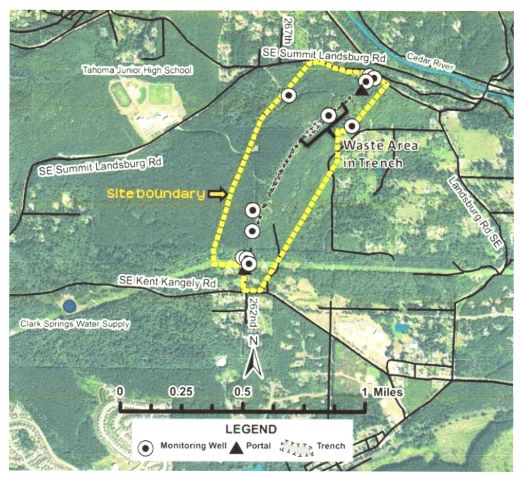Landsburg Mine Site Cleanup
Updated Through November 5, 2019
Landsburg Mine Site Cleanup
The GMVUAC has been tracking progress on the Washington Department of Ecology’s program to cleanup the Landsburg Mine Site south of the Cedar River and generally westerly of the Hobart/Landsburg – Ravensdale Road. View the WaDOE’s March 4, 2019, MS PowerPoint (tm c) presentation and update to the GMVUAC here (19 MB): PowerPoint FilesLandsburg_Mine_GMVUAC_03042019final.
Location Map

Background
This site was a was a former coal mine that was closed after a collapse resulting in the formation of a slip trench at the surface. Over the years this trench had deposited therein toxic/hazardous wastes. This site is now being monitored and subject to cleanup under the State’s Model Toxics Control Act (MTCA).
According to the WaDOE, groundwater has been monitored at the Site using 10 monitoring wells set at various depths and locations. The groundwater was analyzed for around 220 contaminants in order to detect any potential contamination coming from the waste area. In November 2017, low levels of a chemical called 1,4-Dioxane were found at several monitoring wells on the Site. Although these levels were low, they were above allowable levels under state standards of Washington cleanup law, the Model Toxics Control Act (MTCA). The decision was made to install more monitoring wells to help trace the extent of 1,4-Dioxane at the Site. All the site wells were resampled in May 2018 and showed slightly lower levels of the chemical. It had been previously decided to add 1,4-Dioxane to the list of chemicals tested from the Site monitoring wells. The consultant is drilling three additional monitoring wells to further investigate the 1,4-dioxane hits at the north portal — results should be available in early 2019.
1,4-Dioxane — is a man-made industrial chemical that is mixable in water. It is used as a stabilizer for chlorinated solvents, and is a byproduct in many products, including paint strippers, dyes, greases, antifreeze and aircraft deicing fluids. It is also common in consumer products such as deodorants, shampoos, and cosmetics. 1,4-Dioxane is a likely human carcinogen. Low level exposure to 1,4-Dioxane over a lifetime can increase the risk of cancer. However this would mean about a 1/1 million chance of getting cancer if someone drank 2 liters of water per day containing 1,4-Dioxane at 0.35 parts per billion for 70 years. On part per billion is about one half teaspoon of water in an Olympic-size swimming pool. While the risk from 1,4-Dioxane is low, it is a contaminant found at the Site at levels above allowable MTCA levels and must be addressed.
The GMVUAC submitted comments to the Department of Ecology in 2013 on its proposed cleanup plan; please read our letter here: 12/2013 – GMVUAC Landsburg Mine Comments . The Department’s progress and status report for 2015 may be read here: Ecology – Landsburg Mine Site Update – 01/2015 . The Department’s 2017 PowerPoint presentation to the GMVUAC may be viewed here (in .pdf format): Landsburg Mine – GMVUAC – 07/10/2017 .
Detailed information on this site from the Department of Ecology may be obtained and viewed by clicking on the following link: Landsburg Mine Site .
The GMVUAC will continue to monitor and report on the progress of this MTCA cleanup project. From time to time, the GMVUAC invites a WaDOE representative to attend one of its regular monthly meetings and give a progress and status report.
